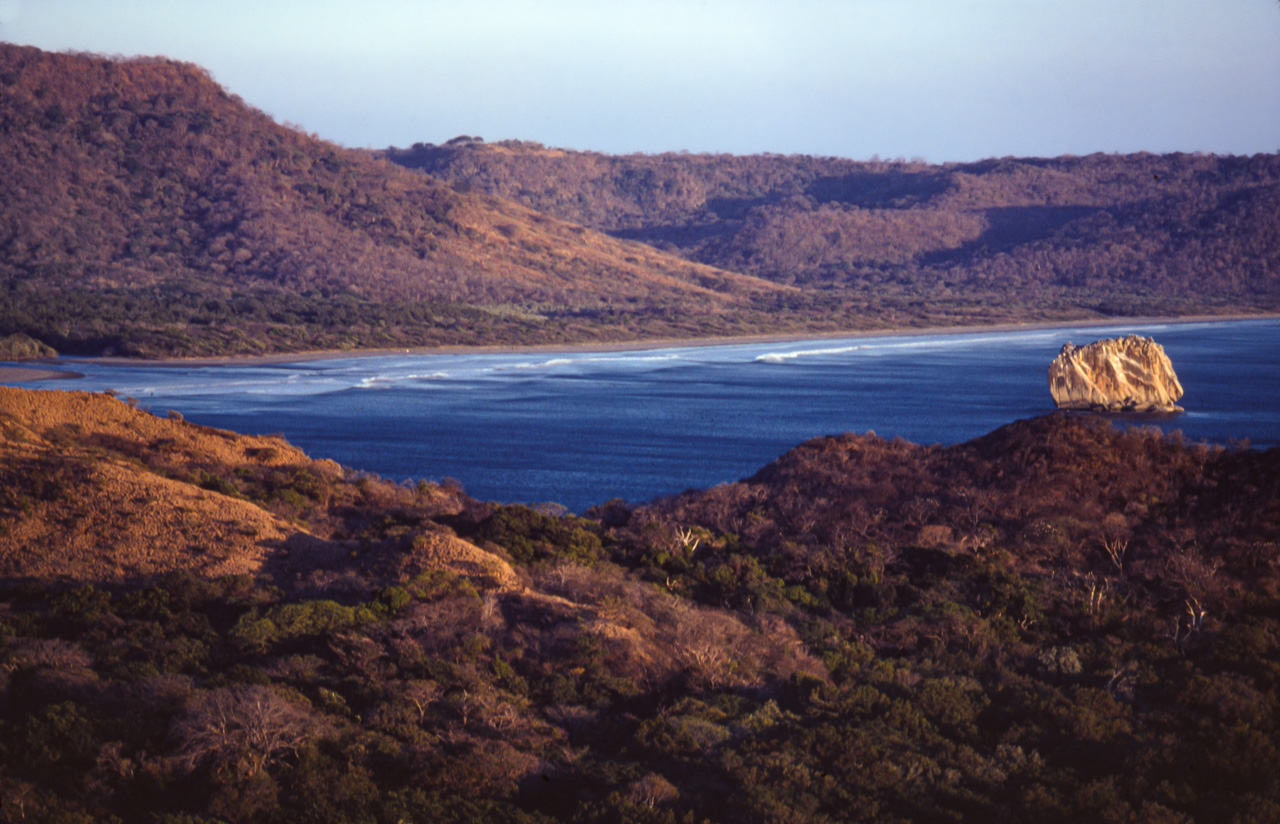After viewing the photos I’ve presented so far you might start to visualise Costa Rica as lush and verdant with raging rivers running through every valley. While that’s certainly the case in the Talamanca mountain range, if you travel less than 300 kilometres as the crow flies to the country’s northwest, to Santa Rosa, Costa Rica’s first national park, you’ll feel more like you’re travelling in the savannahs of Africa. Costa Rica has a ridiculous amount of life zone diversity for such a small country and this – together with its long history of wildlands preservation – is the reason for its success as an ecotourism paradise. You get it all in Costa Rica and can reach any number of life zones within hours.
On one of my many visits to Playa Nancite I got up at dawn and climbed an outcropping on the beach’s northern end until I had a view of the beach to the south – Playa Naranjo and its famous Witches Rock. In the tropics you’ve got an extremely narrow window when the light is decent for photos – either an hour around dawn and an hour around sunset. You had to act fast as close to the equator there is very little twilight when the sun hangs on the horizon like it does in the northern latitudes. I’d usually pack my camera away during the rest of the day as the light was just too crappy. But on this particular day I timed it just right as the sun was rising and illuminated Witches Rock.
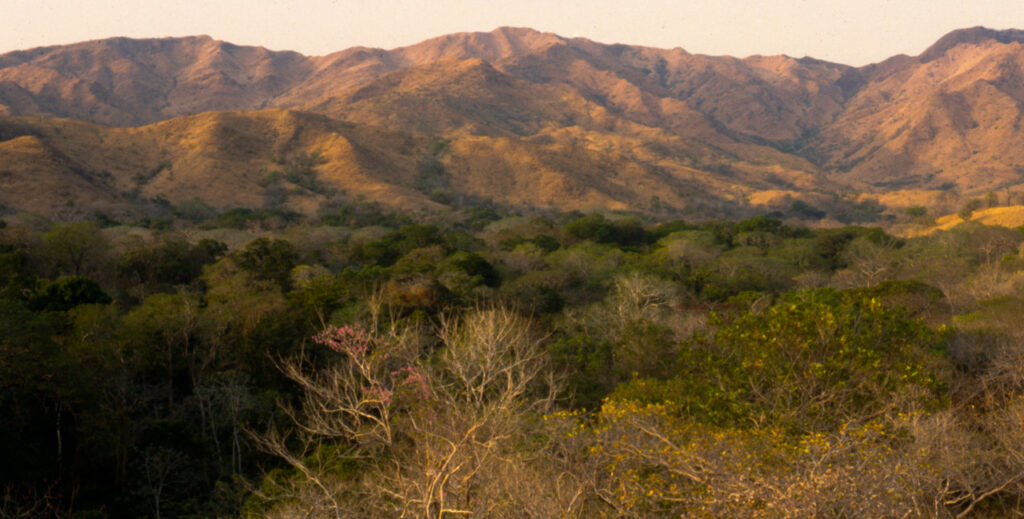
Santa Rosa was originally established as a site of historical importance, but is now one of Costa Rica’s most important parks as it protects some good patches of tropical dry forest and is the home of the Ridley turtle’s arribada on Playa Nancite. Much of the original tropical dry forest was long lost due to generations of grazing on the properties which originally made up the park but since the park’s establishment in 1971 so of that land is being reclaimed by forests.
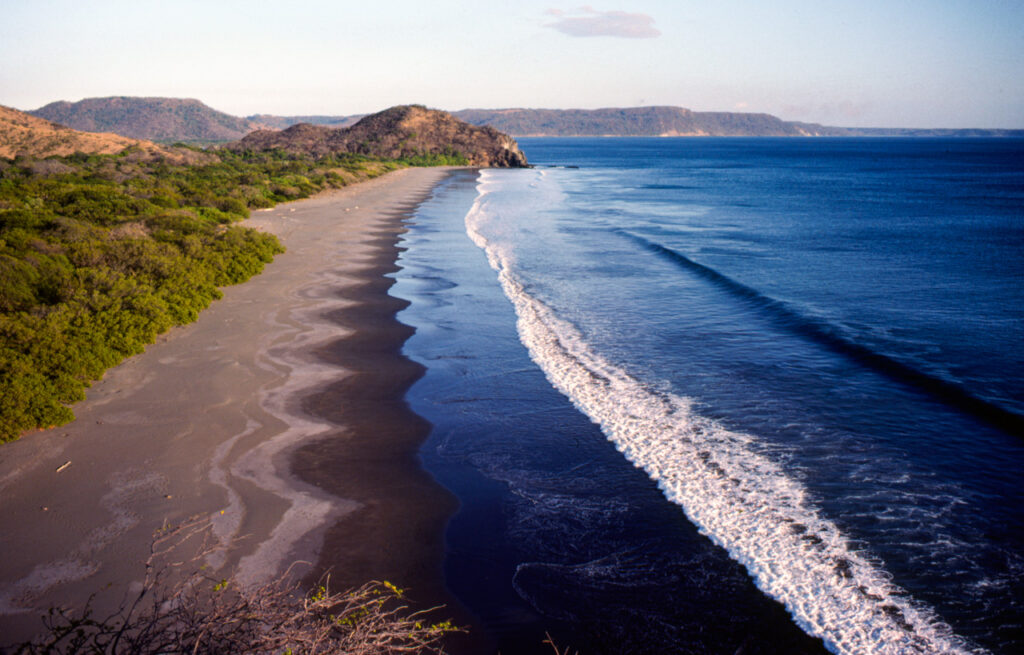
Playa Nancite in Santa Rosa National Park is the famous as the site of the ‘arribadas’ of olive ridley turtles. During the rainy season tens of thousands of ridley will come to the beach to lay eggs. This photo was taken in early morning in the dry season yet one lone ridley got a bit confused with the seasons and came ashore (see the tiny dot on the lower left corner).
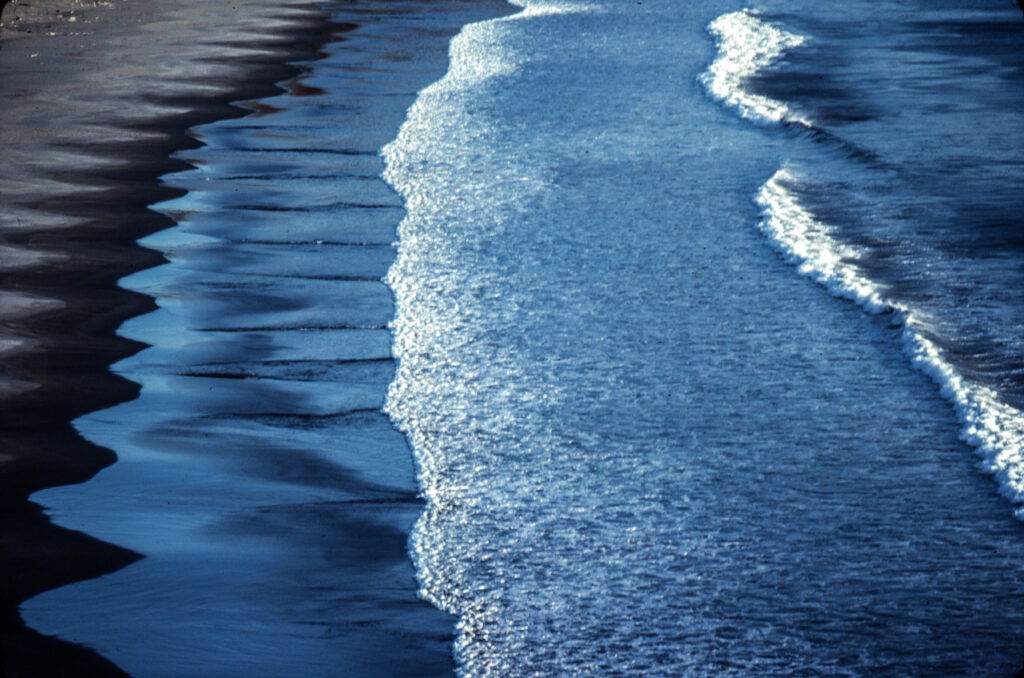
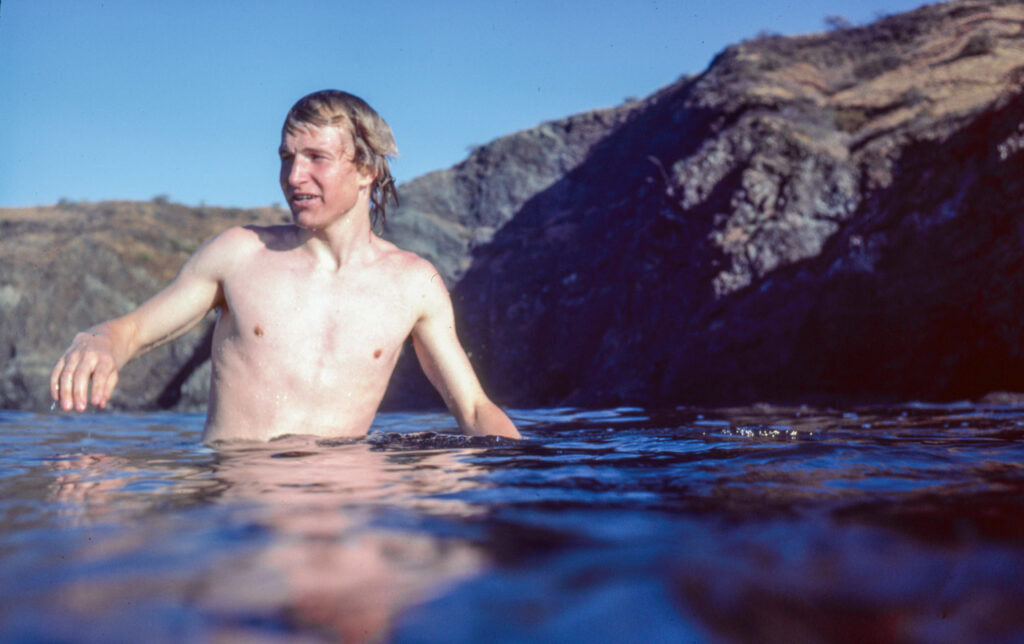
My primary school mate, Dan York, was an early eco-tourist and was able to jam in volcanoes, beaches, jungles and savannahs in a two-week visit in March 1982. We trekked down to Playa Nancite and had the entire stretch of the beach for himself to test out his body surfing skills. Reaching Nancite required a long, hot and dry trek so it was not unusual be alone on the beach.
But Dan’s interests didn’t lie solely in ecotourism. Coincidentally, his long-time girlfriend, Margaret, was taking a semester abroad in Costa Rica and studying as part of a consortium of US universities. One day we all took a trip to Poas Volcano National Park. Dan and Margaret managed to lose me in the cloud forest and found some time alone. Later that night Dan announced that he had proposed to Margaret at the volcano. That volcanic ash must have been magical as 32 years later, Dan and Margaret are still happily married.
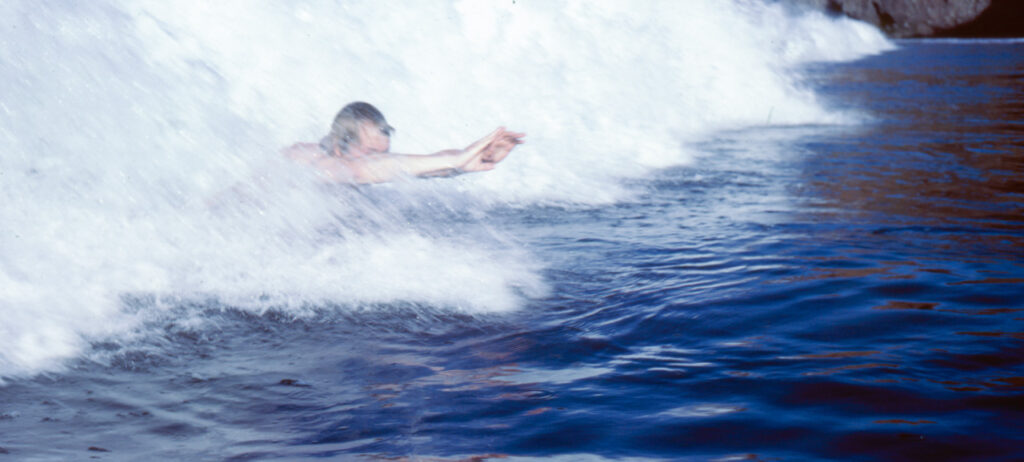
Funny the things you remember after so many years and funny how they can still impact you today. I remember it had been a long and hot hike to Playa Nancite and when we finally arrived at the beach we were ecstatic. Dan had been dying to soak his toes in the Pacific Ocean after flying in from frigid Wisconsin. He stripped his shoes off and walked barefoot in the surf. I was too lazy and left my boots on and hiked to the northern end of the beach and then up across the wide sandy beach to the forest’s edge where we would set up camp. Dan followed barefoot and felt the warm sand between his toes. But that warm sand became hot sand which then became flaming hot sand. It was late in the afternoon and that dark sand had been absorbing heat all day. Dan got halfway and was jumping from foot to foot not knowing whether he should go back to the sea or run for the shade. He decided on the shade and ran the 40 yards with his backpack faster than any NFL running back. When he arrived he rolled in pain and the soles of his feet were fried.
To this day, whenever I see a large patch of sand to cross I always think back to that day and remember Dan’s pain and I put my shoes on never wanting to suffer from scorched feet like Dan did.

One of nature’s most spectacular events occurs on Playa Nancite – a somewhat isolated beach within Santa Rosa National Park. During the rainy season, for 4-5 days each month, tens of thousands of olive ridley turtles will arrive on the beach to lay eggs. The ridleys generally come ashore during the night and lumber up the beach until they find a suitable nesting place. They will dig a hole with their back flippers, lay their eggs and return to the sea.
There was always one constant on Playa Nancite and that was Steve Cornelius, a US turtle researcher. Steve literally wrote the book on the sea turtles of Santa Rosa National Park and had been studying the turtles since 1972 when he was a Peace Corps Volunteer working with the Costa Rican National Park Service. Whenever I arrived Steve always put me to work as he always needed volunteers. I remember on my first visit I asked Steve if we’d see an arribada that night. He said he thought there would be. I asked him why thinking he’d give some explanation that the moon was in the third quarter and some other scientific reason. ‘Why tonight?’ he said. ‘Because my big toe is throbbing.’ It was a bit hit and miss to time an arribada. You had to have a bit of luck, a lot of time or a lot of faith in Steve’s toe.
I remember catching an early snooze on my first visit in October 1981 and in the middle of the night Steve shakes my tent and calls out ‘They’re here!’ I crawled out of my tent and grabbed a torch and headed out to the beach. I couldn’t believe what I was seeing. There were turtles EVERYWHERE. It was like the D-Day invasion at Normandy. Each wave would bring in another platoon ready to claim a bit of the beach. I could not take one step without having to step on a turtle’s back. If I stood in one place for longer than a few minutes, a turtle would bang into me. There was sand flying everywhere as turtles would dig their holes. And there were eggs everywhere. There were too many turtles and not enough beach – turtles would dig up the nests of other turtles. I can’t remember what Steve was doing – possibly tagging turtles – but I’d see him in his accessory vest jumping from clear spot to clear spot along the beach. A man clearly in his element.
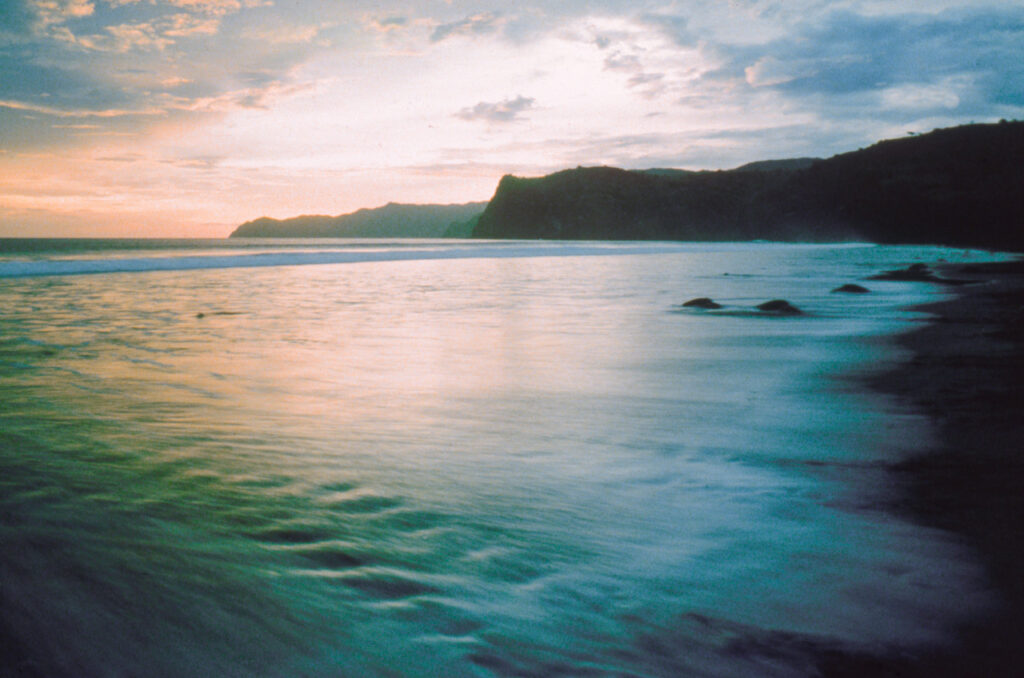
If you visit Playa Nancite enough times you might witness a daytime arribada when you can see the entire beach covered with turtles. I was never so lucky and only saw the arribadas at night and therefore don’t have any photographs which show how massive an arribada is. Regrettably the only photos I do have are low quality duplicates as all the photos I took remained in Costa Rica. I don’t recall any night time photos I took and I do seem to recall that Steve Cornelius didn’t want me to use flash at night. So my arribada photos are limited to those early arrivals who would come at sunset.
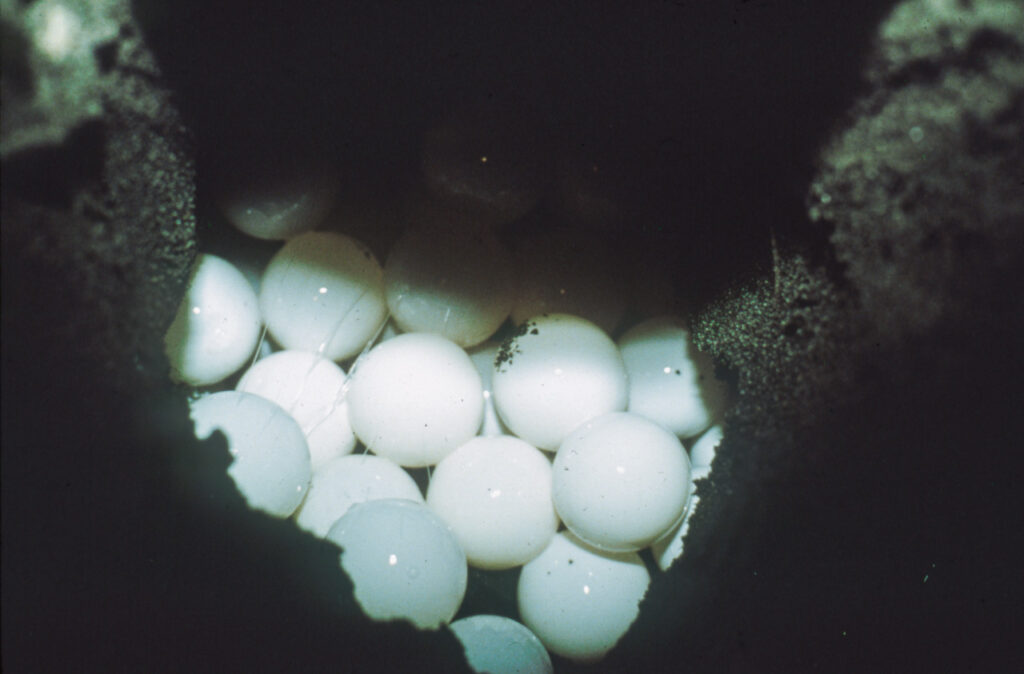
Turtle eggs look like ping pong balls and are about the same size. In about 50 days they will hatch.
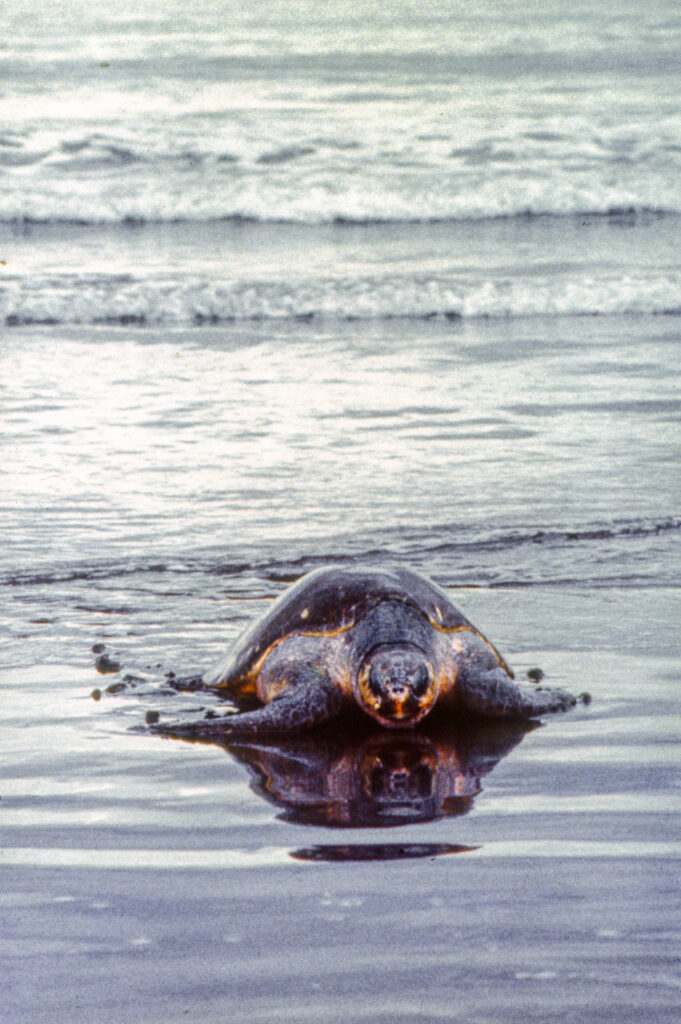
A ridley begins her long ascent of the beach to lay her eggs.
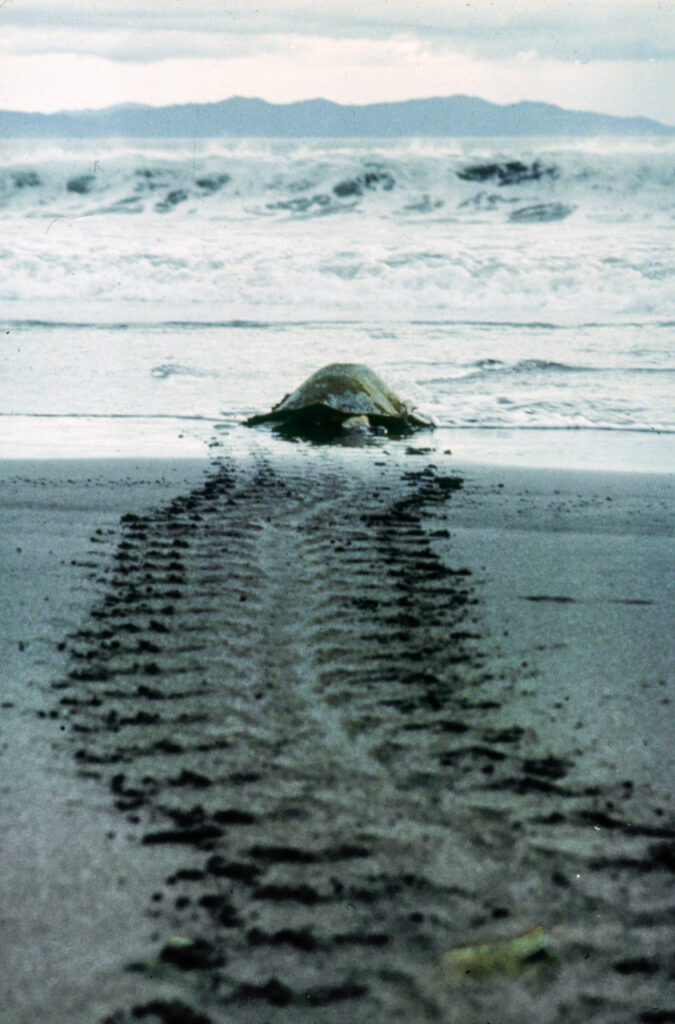
A ridley returns to sea after laying her eggs. A couple of months later the eggs will hatch. The success rate is extremely low as many of the nests are destroyed on the first night or first morning by various animals and birds. If the turtles do hatch then they have a long and perilous scramble to the sea and are easy pickings for birds and other animals.
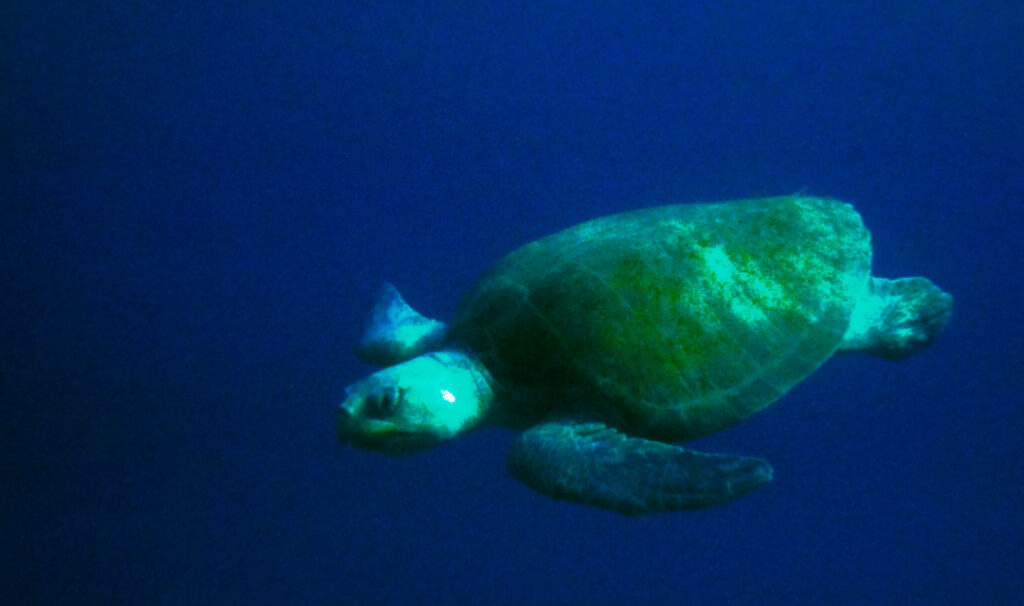
If someone were to ask me what my greatest adventure in nature has been I would answer without a moment’s hesitation that is was the time I swam with the turtles during an arribada.
The National Park Service had a Nikonos underwater camera yet no one knew how to use it so they lent it out to me. On one trip to Playa Nancite during arribada season I decided to put it to use. During the day, the Ridley turtles would swim up and down the coast line beyond the breakers, just waiting for the evening when they could lay their eggs. I grabbed the camera, mask and snorkel and swam out to join them. Every now and then a turtle would get caught in a wave and you’d see them surfing along – I had to make sure I got past the breakers without getting a turtle crashing down on my head. As soon as I got beyond the breakers I was surrounded by turtles who were just casually swimming along as if on a Sunday stroll. At first I forgot the camera and swam underwater and would catch a free ride by grabbing the hind shell of the turtles. A Ridley turtle isn’t very big so I didn’t hang on for too long. After a few rides I figured I’d better try to take some pics.
The Nikonos III was a fully manual rangefinder so I had to set everything – the focal plane, shutter speed and f-stop. It was all too hard. I was treading water for the longest time, looking through my mask underwater and trying to get the settings right and had become oblivious to what was happening around me. Finally I looked up from the camera and a Ridley turtle was treading water no further than arm’s length away. She was staring at me and no doubt wondering what sort of odd sea creature I was. I stared right back at her and for what seemed the longest time we just watched each other and I felt the most incredible connection with this beautiful animal. Finally I remembered the camera and raised it and got the shot and she paddled away.

